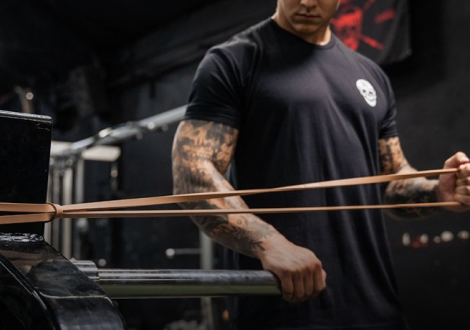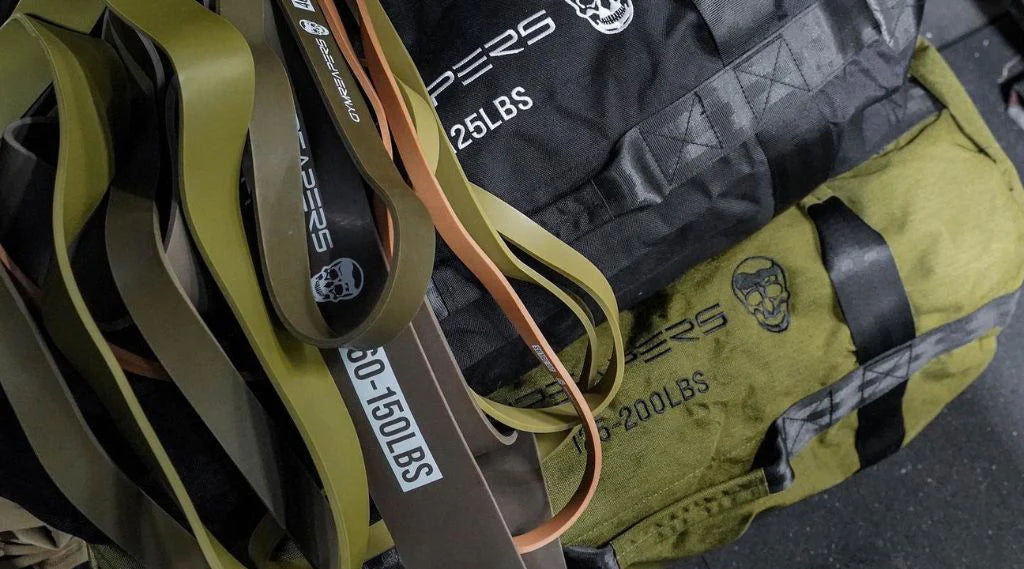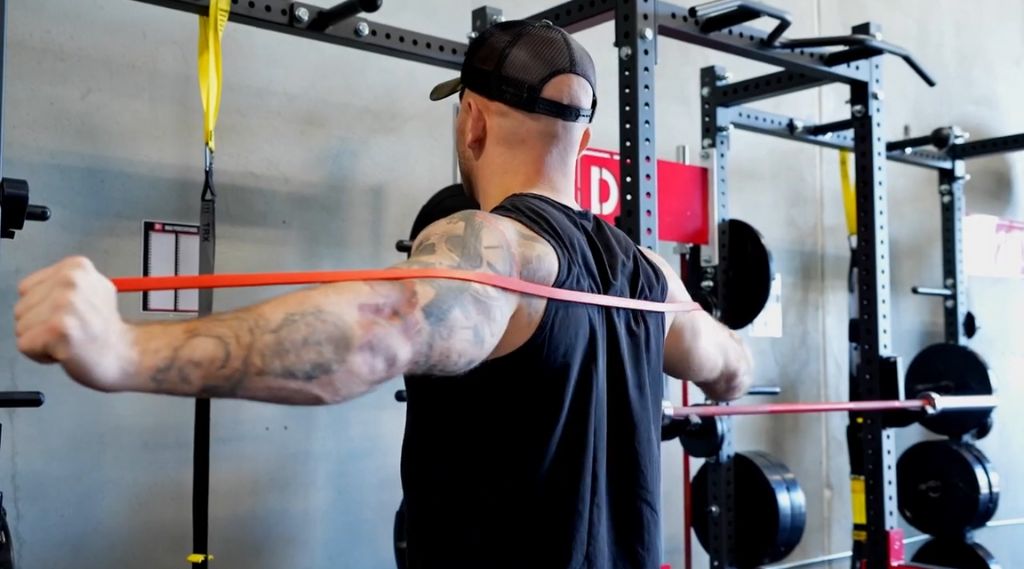If you want to lose weight then you may be wondering if training with bands is helpful for weight loss or if training with bands is a waste of time.
When used correctly, bands can help you lose weight. Their versatility allows you to do multiple effective exercises to burn calories, train all the major muscles in your body, and maintain lean mass while shedding fat.
To get the most out of your training with bands while dieting, it’s important to understand how bands help with weight loss, how to optimize your workouts, and what bands to use.
Key Takeaways
Can You Lose Weight Using Resistance Bands?

Yes, you can lose weight using resistance bands as long as you pair your resistance band training with a consistent calorie deficit (eating fewer calories than your body needs to maintain weight).
A small to moderate calorie deficit is necessary to lose weight because it forces your body to break down fat for energy. Training with resistance bands can help you achieve a calorie deficit by increasing the number of calories you’re burning.
For example, let’s say that you’re eating 2500 calories and maintaining your weight; if you start training with bands and burn 200 calories per workout, then this puts you in a 200-calorie deficit, which will allow you to lose weight.
Ultimately, weight loss occurs when your total daily energy expenditure (TDEE) > total calorie intake.
How Resistance Bands Help You Lose Weight
There are a few different ways that resistance band training can increase your overall energy expenditure:
Increase Caloric Expenditure
Resistance band training is a form of physical activity that burns calories. Regularly doing band workouts can boost your total daily energy expenditure (TDEE), making it easier to maintain the necessary deficit for weight loss.
That said, don’t fall for the trap of doing countless high-rep sets with the lightest bands, thinking that it will help you shed more fat or tone your muscles.
Doing too many reps generates unnecessary fatigue and hinders your performance in subsequent workouts.
I’ll teach you how to maximize your band training for weight loss in the next section.
Related: Resistance Bands Vs Weight: What Are the Differences?
Encourage Muscle Growth
Resistance band exercises can provide enough muscle stimulus to promote growth, even while dieting to shed fat. The process is known as body recomposition and is possible mainly for inexperienced trainees and those returning to training following an extended break.
Growing muscle may seem counterproductive when your goal is to lose weight, but the more muscle you have, the more calories you burn per day (even while at rest). This is because it costs your body more energy to maintain muscle mass, so you burn extra calories just by having more muscle.
Promote Muscle Retention
Even if you’re not in a position to build more muscle while dieting (i.e. you’re a more experienced lifter), the muscle stimulus that bands provide will allow you to retain more of the lean tissue you already have (rather than burning it for energy).
This is a classic example of if you don’t use it, you lose it, and if you lose it then you burn fewer calories per day, making weight loss more challenging.
Related Article: Best HIIT Workouts With Resistance Bands
Improve Consistency
Resistance band workouts can be easier to keep up with even when your energy levels are low because of your calorie deficit. Resistance band workouts are generally easier to recover from, more convenient to do at-home or while traveling, and have less of a learning curve than other strength equipment.
Bands are light, portable, and affordable, which means you can purchase a set and train at home if you can’t make it to the gym and still get a quality workout to help with weight loss.
Resistance bands offer constant tension and linear variable resistance (the tension increases as a band stretches), which can improve muscle activation, allowing you to achieve better muscle stimulus without training as long or using as much resistance.
Related Article: The Best Way to Use Resistance Bands (For Beginners)
How To Maximize Resistance Band Training For Weight Loss

Here are 6 tips for making the most of your band training while dieting:
1. Focus on Compound Exercises
Compound exercises (exercises that involve multiple muscle groups) are ideal for weight loss because they burn more calories than isolation movements (exercises that target one muscle group) as they work more muscles at one time, which requires more energy.
Some examples of compound movements with bands include:
- Banded squats
- Banded deadlifts
- Banded bench press
- Banded pull ups
Compound movements also allow you to maintain strength more effectively than isolation movements because you can lift heavier in compound movements than you can with isolation exercises.
Lastly, compound exercises are more time efficient because you can target more muscle groups in less time than you could with isolation exercises.
For example, instead of doing exercises for your upper chest, shoulders, and triceps, you can do a few high-effort sets of standing band shoulder presses targeting all the same muscle groups.
2. Do Isolation Movements Sparingly
Isolation exercises like bicep curls and lateral raises are valuable and often fun to do. However, they also generate fatigue, which can be more challenging to recover from while dieting, (especially when you’re prioritizing compound movements).
Because of that, I recommend doing isolation movements sparingly and only if you feel up for the task.
For example, here are some band isolation exercises to consider:
- Bicep/hammer curls
- Overhead tricep extensions
- Tricep kickbacks
- Lying/seated hamstring curl
- Seated leg extensions
- Lateral and front raises
- Bent-over reverse fly
- Face pulls
- Pull-aparts
- Chest fly
- Glute kick
If you’re tired, then feel free to skip these movements and focus on your compound lifts instead.
3. Train Hard Enough

Training hard enough sounds like a no-brainer, but you’d be surprised how many people don’t push themselves enough to make progress. They train until they feel mild to moderate discomfort and stop the set before they reach the truly effective and stimulative reps.
One way to find how much you can tolerate is to perform the occasional AMRAP (as many reps as possible) set. These sets show you where your limits lie, allowing you to more accurately gauge your effort and how close you are to failure.
For example, say you do an AMRAP set of band push-ups and get 27 reps. That means you should generally come within 5-6 reps of that number each time you train and on every set (with the same level of resistance).
Adjust the level of resistance that you’re using based on the number of reps you plan to perform. It should be a challenge to complete the reps that you have programmed, but not so challenging that you’re reaching technical failure (this would be harder to recover from while in a deficit).
4. Pick the Right Band
Choosing the right band for each exercise is as important as selecting the appropriate load when lifting free weights or using gym machines.
You need to challenge your muscles just enough to see results while also being able to train through a full range of motion with proper form.
When planning your workout and choosing the corresponding levels of resistance, use the following rep schemes:
- Compound lifts (banded push-ups, squats, Romanian deadlifts, etc.): 6 to 10 reps
- Assistance movements (lat pulldowns, horizontal rows, chest press, etc.): 10 to 15 reps
- Isolation activities (bicep curls, lateral raises, tricep extensions, etc.): 15 to 25 reps
For assistance and isolation movements, one band is likely sufficient; however, for compound movements, you may need to combine two or more resistance bands to get the necessary tension.
For example, if you get the military band set by Gymreapers, you can pick from five bands and combine them to challenge yourself on compound lifts.
5. Maintain Proper Form
To get the most out of your resistance band training, performing each movement correctly with the proper technique is important. This will allow you to train your muscles effectively to encourage muscle growth and retention and it will also reduce your risk of injury.
Start by doing slower repetitions to focus on activating the right muscles and avoid using momentum to complete your reps.
6. Apply Progressive Overload

Bands make it more difficult to tell if you’re progressing, but that’s no excuse to do the same workouts forever. Just because you’re dieting doesn’t mean progression has to stall until you increase your calorie intake.
Always strive to make some progress, even if just one or two extra reps per week. Doing so will allow you to create a strong training stimulus to maintain your muscle and ensure that you’re working hard enough.
“As the body adapts to the current resistance training program, the client will notice the same sets and reps are no longer difficult to complete. There are several levers the trainer can pull, such as increasing the repetitions, intensity, timing, distance, or introducing a variety of movements to increase the demand on the muscles.
-Andre Adams, master NASM trainer, and physique contest prep coach
Sample Resistance Band Workout For Weight Loss
Here is an effective full-body band workout you could implement during a weight loss phase:
|
Exercise |
Sets |
Reps |
Rest Period |
|
Band-assisted chin-ups |
3 |
RPE 8-9 (1-2 reps in the tank) |
2-3 mins |
|
Band squats |
3 |
8 to 12 |
1.5-2 mins |
|
Banded push-ups |
3 |
RPE 8-9 (1-2 reps in the tank) |
1.5-2.5 mins |
|
Romanian deadlifts |
2-3 |
10 to 15 |
2 mins |
|
Standing band shoulder press |
2-3 |
10 to 15 |
1.5-2 mins |
|
Band lat pulldown |
2-3 |
12 to 15 |
1.5-2 mins |
A few notes:
-
Chin-ups and push-ups can be more challenging to recover from, so feel free to take longer breaks if needed.
-
Loop the band behind your head and under your feet for squats.
- Feel free to include an isolation exercise or two for the biceps, triceps, shoulders, or calves (examples listed above) if you feel up to it and are adequately recovered.
Best Resistance Bands To Use For Weight Loss

I recommend the Military Resistance Band Set by Gymreapers. It includes five loop bands, each offering a unique resistance range:
- Desert Tan: 20-35 lbs.
- OD Green: 30-60 lbs.
- Dark Earth: 40-80 lbs.
- Ranger Green: 50-120 lbs.
- Coyote Brown: 60-150 lbs.
You can use these bands as the primary source of resistance to train all the major muscle groups in your body and increase your energy expenditure to make weight loss easier.
How Long Does It Take To See Results From Resistance Bands?
The amount of time it will take to notice results with resistance band training depends on your starting point, diet, and adherence. That said, most people should see good results within six to eight weeks of training with bands as long as they are maintaining a calorie deficit.
New trainees with little to no muscle and higher body fat percentage can experience body recomposition (simultaneously losing fat and gaining muscle), allowing for quicker visual improvements.
Experienced lifters may not notice any muscle growth while in a deficit, but they will notice that they retain their current muscle mass as they lose fat.

















Leave a comment
All comments are moderated before being published.
This site is protected by hCaptcha and the hCaptcha Privacy Policy and Terms of Service apply.